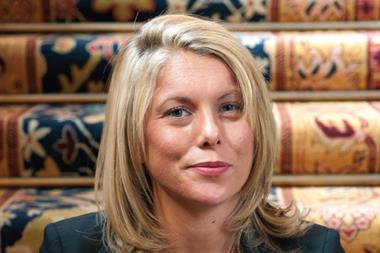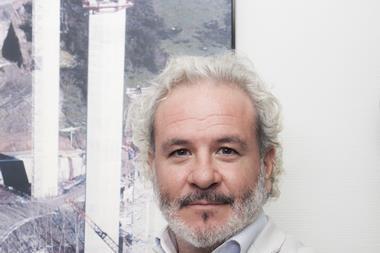Focusing on the smaller things is crucial for risk management in the transport sector, according to Bombardier’s head of risk engineering
Coming from an engineering background, Malwine Braunwarth finds being head of risk engineering, global risk management and insurance at the multinational aerospace and transportation firm Bombardier just about the perfect job.
“I love fast trains,” she says. “There are more than 100,000 rail vehicles in operation and because of my extensive travel I’ve already used several of them. I love speed – especially when it comes in combination with our smart energy-saving ECO 4 technologies.
“Bombardier’s Zefiro will be my chosen train going on vacation in 2014 when I go travelling through Italy. The V300 Zefiro can reach a speed of up to 360km per hour and will link north and south Italy – I like that 360km per hour speed.
“Having used one of our Zefiro trains already in China, where they have already been in use for four years, I know that it will be a very comfortable journey.”
The new C Series aircraft are another favourite.
“They are one of the quietest commercial aircraft in production,” she says. “As I know many people who live near the airport in Berlin, I know personally how much noisy aircraft can affect people’s quality of life.”
But hi-tech engineering like this requires a comprehensive approach to risk, and when Bombardier staff tuned in to watch a live feed of the maiden flight of the C Series 100 on 16 September 2013 it was the culmination of a sophisticated programme of analysis and risk management.
“We have to make sure that the assembly of the aircraft doesn’t face any delays from supply chain problems or incidents at the facility itself,” says Braunwarth.
Risk engineering for the C Series’ assembly sites, for example Belfast, Northern Ireland or Mirabel, Quebec, was carried out in line with Bombardier’s corporate standards relating to construction, occupancy, protection and exposure – just one set of directives that Braunwarth believes makes the firm a world leader in risk management.
Prepare for any eventuality
The overall mandate of Bombardier’s Global Risk Management and Insurance is to adequately protect the assets and liabilities of the Bombardier Group. “We look at the big picture,” says Braunwarth. “We look at risk based on our entire product range and our worldwide portfolio across product liability, risk during the development phase, supply chain risk, high-value concentration, property and business interruptions scenarios, builder risk and wrap-up.
“We act as internal consultants to Bombardier Group companies on risk management, insurance, loss prevention, risk engineering, claims settlement and marine cargo insurance matters.
“You never quite know what a typical day will bring. For example, I arrived at work this morning and received a call to say one of our trains had derailed, which obviously required my attention immediately.
“We have a small team, only 12 people, but overall our department deals with about 300 proposals a year on various projects, with our response led by Bombardier senior director of global risk management and insurance Daniel Desjardins.
“We closely examine contract terms and conditions, examining indemnities and meeting insurance requirements,” says Braunwarth.
“Our aims are to minimise the frequency and severity of losses through implementation of loss prevention measures; provide effective loss control by assisting in the equitable settlement of losses or in the defence of third-party claims and to minimise the effects of large, unexpected losses through effective risk transfer.
“Our philosophy at Bombardier is that there is nobody that understands our risk better than Bombardier.”
In line with many multinationals, Bombardier is increasingly aware of the complexities of international work. “If there is one risk that keeps me up at night it is supply chain,” says Braunwarth.
“Even before the March 2011 event in Japan we launched a major business continuity and supply chain exercise with Marsh risk control consultants, their engineers and forensic accountants to help evaluate the business continuity risk of some of our key facilities.”
One of the reasons for this early action was the 2010 flood when the River Spree burst its banks and flooded a 90,000sqm Bombardier manufacturing site in Germany.
The speed and pure volume with which the normally small river that ran adjacent to a Bombardier manufacturing site flooded the facility meant even the best planning wasn’t enough to avert disaster.
The sheer size of the facility meant that a huge amount of equipment and stock was exposed to potential damage. “We knew what we needed to do in the event of a flood. For example, using sandbags and lifting equipment and stock off the floor. But within fewer than three hours the flood level had reached a height of 1.65m,” Braunwarth says.
Learning process and being at a project’s start
Braunwarth and the team had to fi nd the best way to restore activities and get back to business as quickly as possible.
“Although the cleanup was completed within about a month, it took almost a year for everything to return to normal,” she says. “However, we didn’t lose a single contract due the flood and the insurance claim was settled within a year.
“We certainly learned a lesson. Now we invest even more time evaluating natural hazard exposures, investing in physical protection measurements, educating site personnel on the threat of catastrophes and being more prepared for the unexpected.”
This learning process fits in with what Braunwarth sees as a trend towards an increase in natural catastrophes.
She says that to fully appreciate your exposure it’s important not to make the mistake of only focusing on where you spend the most money – you need to make sure that you are focusing on the smaller, potential high-impact suppliers of critical subcomponents, items with long replacement times, supplies that can only be obtained from a single source, those with a long lead time and components that are vital to safety standards.
“It is critical that we are involved early in any project,” says Braunwarth. “We are very good at the traditional risks – fire, property, that kind of thing – and we are getting more and more expert at looking at the emerging risks [see box].
“It can be challenging operating across many countries, with different legislation and operating environments. I was at a meeting recently in Casablanca and I would say that we had eight nationalities around the table, all different languages. Being female, being involved in this international project, being the only one there from the customer side – you need to be prepared and you need to listen as well as lead.”
Braunwarth believes that the risk manager needs to be a connector between the internal and external aspects of a project.
“You need to be not only technically focused, but you also need to lead a meeting in such a way that everyone feels able to give their opinion,” she says. “People are usually willing to engage with risk management if they understand that we are not a remote department that is just bringing extra cost, and the best way to make sure people understand that is to be there on a project from the beginning.
“It’s about showing how you can make things run more smoothly, more safely and save people time and money.
“Risk management is a daily learning curve – be open minded.
CV
Malwine Braunwarth holds an MSc in civil engineering from the university of Karlsruhe, Germany
After graduating in 2000 she worked for three years as a project engineer in the traffic and transport planning sector before being hired by FM Global as a loss prevention engineer
Braunwarth joined Bombardier Transportation in 2008 and was appointed head of risk engineering in 2011
She is a member of the German risk management association DVS Deutscher Versicherungs- Schutzverband
Her hobbies include golf and improving her Swahili
Examination of different risk scenarios
Reputation
“Globalisation coupled with the growing and fast-moving internet world will intensify reputational risk, making it increasingly difficult to deal with,” says Braunwarth.
“Content posted on Facebook, Twitter and other social media platforms has the potential to reach billions of users within seconds.
“People often form opinions based on what has been tweeted or posted on an online social media website – even if it may not be true. Personally, I would consider reputational risk as the hardest threat to control for any business.”
Cyber
Increasingly complex, interconnected networks working across multiple sites and nations – and interacting directly with customers – expose firms to a rapidly evolving risk.
“Several questions about cyber risk were raised at the DVS symposium last September,” says Braunwarth.
“What amount should be insured?’, ‘Will insured parties get adequate cover?’ But these are questions that should only be raised after the potential insured has thought through and formed a detailed understanding of the related loss scenarios.
“Ultimately, both insured and insurers need to do their homework and find some time to form a common agreement and understanding of related risk scenarios.”
Supply chain
The vulnerability of international supply chains has been exposed time and again, and smart companies are working hard to re-analyse their exposure to this risk.
“Bombardier’s interest is to understand and evaluate the risks in and around our supplier’s site location and try to quantify the interconnected risks – such as nat cats – that could affect suppliers down the global supply chain,” says Braunwarth.
“Climate change and the increase in natural disasters will continue to affect global supply chains. A natural catastrophe in one country will affect the availability of supplies in another. You need to know where your suppliers are located and understand how products are going to be transported and what the route is.
“At Bombardier, we have a very robust strategy and, together with our insurers and business units, we will go on to work with the different threads to our business, which will help us return to normal operation after a catastrophic event.”




















No comments yet